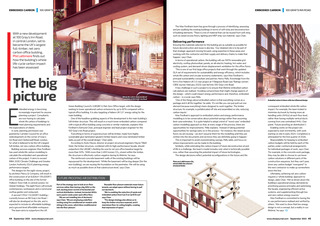




EMBODIED CARBON | 100 GRAYS INN ROAD With a new development at 100 Grays Inn Road, in central London, set to become the UKs largest full-timber, net zero carbon office building, Phil Lattimore finds out how the buildings whole life-cycle carbon impact has been assessed The big picture E mbodied energy is becoming increasingly important for anyone planning a project. Consultants are now having to calculate whole life carbon of buildings to meet planning requirements and the expectations of clients. In June, planning permission was granted by Camden Council for an office redevelopment on the corner of Grays Inn Road and Clerkenwell Road, London, for what is believed to be the UKs largest full-timber, net zero carbon office building. Building services engineer Max Fordham has used whole life carbon modelling to calculate the embodied and operational carbon of the project. It aims to exceed RIBA 2030 Climate Challenge and Greater London Authority (GLA) planning energy performance targets. The designs for the eight-storey project, by architect Piercy & Company, will result in the construction of an 8,826m2 (95,000ft2) office building on the site of the former Holborn Town Hall, in central London, for Global Holdings. The eight floors will include contemporary workspaces and a communal rooftop garden and restaurant. A second 1,115m2 (12,000ft2) building currently known as 88 Grays Inn Road will also be developed on the site, and is expected to include six affordable buildings and a ground-level affordable workspace. The team aims to outperform the UK 44 September 2023 www.cibsejournal.com Whole life carbon was considered carefully at 100 Grays Inn Road Green Building Councils (UKGBCs) Net Zero Office target, with the design seeking to lower operational carbon emissions by up to 82% compared with a typical office building. It is also targeting a Nabers UK 5.5* energy rating for the main building. One of the headline-grabbing aspects of the development is the main buildings full-timber structure. This will result in a much lower embodied carbon compared with a typical office building using concrete or similar materials, explains Max Fordhams Edmund Chan, principal engineer and lead project engineer for the 100 Grays Inn Road project. Everything in terms of superstructure will be timber, made from highly sustainable glue-laminated (glulam) timber beams and cross-laminated timber slabs as part of the overall design, Chan adds. According to Andy Heyne, director at project structural engineers Heyne Tillett Steel, the timber structure, combined with its high-performance faade, should outperform the UKGBCs Building the case for net zero office baseline target by more than 50%. With more than 2,400 tonnes CO2e stored within the timber, the structure is effectively carbon negative during its lifetime, he says. The reinforced-concrete basement walls of the existing buildings will be repurposed for the development. While the basement will be dug deeper [for the new building], we are reusing the foundation on the perimeter. We will be using as much as possible down at that substructure level, says Chan. FUTURE-PROOFING AIR DISTRIBUTION Part of the strategy was to look at on-floor services rather than having a big AHU on the roof, ducting down via lots of horizontal and vertical distribution. Instead, horizontal AHUs were used in voids under each office floor. We are not installing lots of ductwork, says Chan. We are employing underfloor cooling using five conditioned air module units sitting in the cores, which blow conditioned air into the floor plenum. Reusable floor plenum materials mean future tenants can adapt space without having to pull out ductwork. Were enabling the reduction of waste and embodied carbon from Cat A to Cat B fit-out says Chan. The design strategy also allows us to keep the timber structure exposed, and it maximises floor-to-ceiling heights, creating that impression of space.